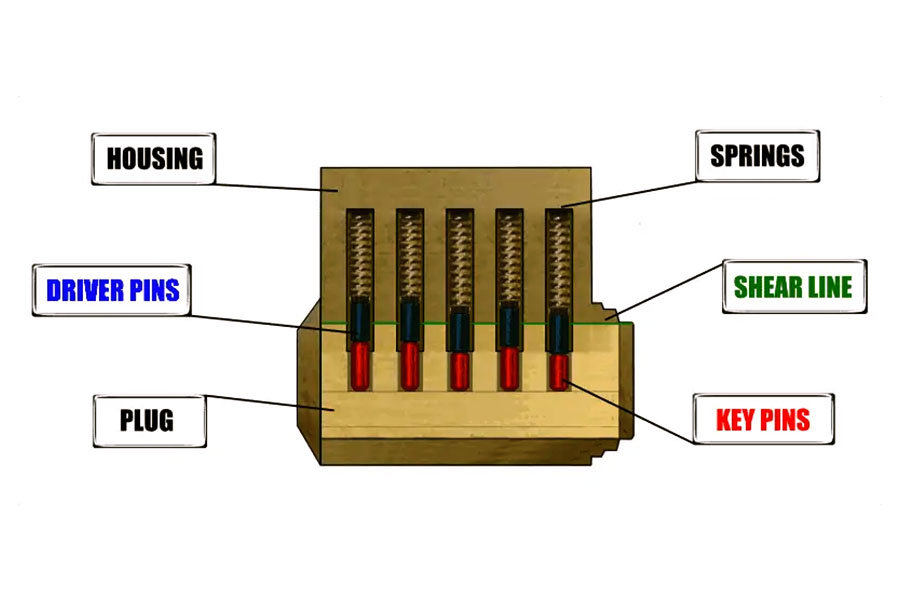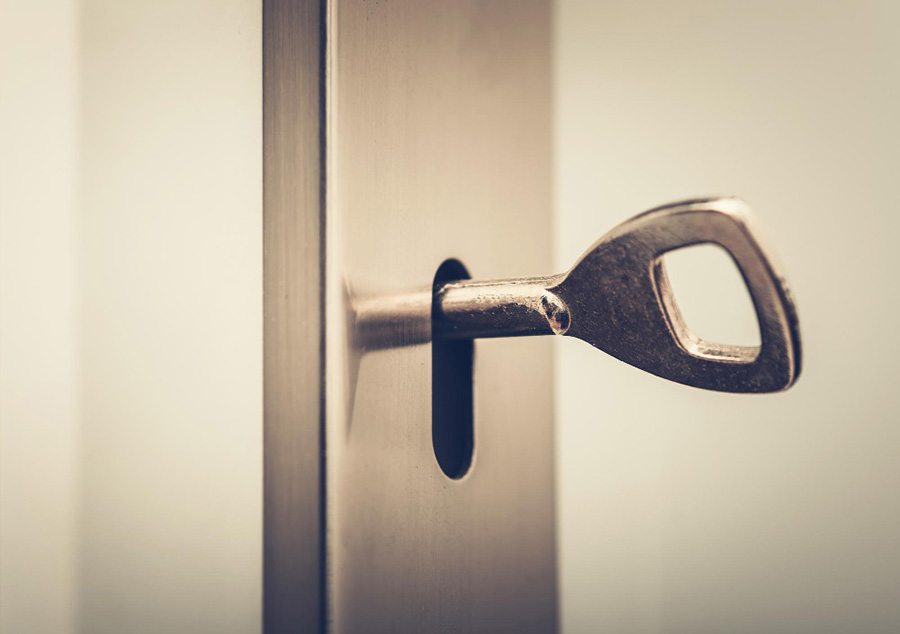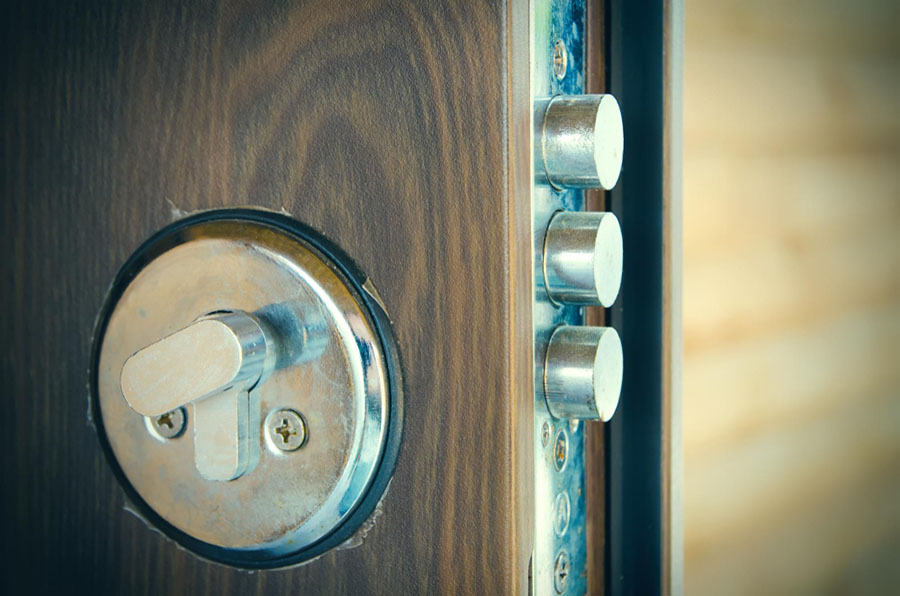Locks have been an integral part of our lives for centuries, providing security and peace of mind for our homes, businesses, and personal belongings. These seemingly simple devices are actually marvels of engineering, consisting of numerous intricate parts working in harmony to keep our possessions safe.
Whether it’s a traditional padlock, a sophisticated electronic lock, or a standard door lock, each type has its own unique set of components that contribute to its functionality. Understanding the different parts of a lock can be fascinating and practical.
It can help you better maintain your locks, troubleshoot issues, and even make informed decisions when purchasing new security systems. Moreover, this knowledge can be invaluable in emergency situations where you might need to describe a problem to a locksmith.
In this article, we’ll delve into the world of locks, exploring what are the parts of a lock called and how they work together.

What Are the Parts of a Lock Called?
Cylinder
The cylinder is the main body of a lock, housing most of the internal components. It’s typically a round or oval-shaped metal casing inserted into the door. A properly functioning cylinder is essential for the security and operation of the lock.
The cylinder contains two crucial elements – the keyway and the plug.
Keyway
The keyway is the shaped opening designed to accept a specific key shape, guiding it into the correct position within the lock. Each keyway has a unique profile matching the key’s blade shape, ensuring only the correct key can fully enter.
There are various types of keyways, including paracentric and restricted designs, each offering different levels of security.
Plug
The plug is the cylindrical part that rotates within the lock cylinder, containing the keyway and interacting directly with the key. Its rotation operates the lock mechanism, aligning the plug’s components with the rest of the lock to open or close it.
The plug contains holes or slots for the pins or wafers, which extend from the plug into the cylinder body.
Pins
In pin tumbler locks, there are two types of pins – driver pins (upper pins pushed down by springs) and key pins (lower pins that directly contact the key). These pins are the primary security components, preventing the plug from rotating when the lock is secured.
Some locks use specialized pins like spool, mushroom, or serrated pins for increased pick resistance.
Springs
Springs are small, coiled metal components that provide constant upward pressure on the pins or wafers, keeping the lock secured when no key is present. They play a crucial role in resetting the lock mechanism, pushing the pins back into their original positions when the key is removed.
The strength of these springs is carefully calibrated to secure the lock without making key insertion difficult.
Shear line
The shear line is an imaginary line where the plug meets the cylinder body. When all pins or wafers align at this line, the plug can rotate. This alignment is crucial for the lock’s operation, as it’s the point where separation between stationary and moving parts occurs, allowing the lock to open.
Wafers and security features
In wafer locks, flat wafers are used instead of pins, performing a similar function by preventing the plug from turning unless properly aligned.
High-security locks may incorporate additional features like sidebars or finger pins, requiring the key to have extra features to operate the lock.
Some cylinders have hardened steel inserts to prevent drilling attacks, while others may use multiple shear lines for added security, making the lock much harder to pick. These advanced security measures require more precise manipulation of the internal components, significantly increasing the lock’s resistance to unauthorized entry attempts.
Additional Components in Specific Locks
Locks are complex mechanisms composed of various essential components. The cylinder houses the internal workings, including the keyway and plug. Pins or wafers, along with springs, form the core security elements, preventing unauthorized access. The shear line is crucial for the lock’s operation, allowing the plug to rotate when all components align correctly.
Additional parts like the housing, cam, bolt or latch, and strike plate contribute to the lock’s overall functionality and security.
In electronic locks, actuators convert electrical signals into mechanical motion. The tailpiece connects the cylinder to the locking mechanism in many designs. Understanding these components is vital for appreciating the intricacy of lock design and the various ways locks provide security in our daily lives.

Common Lock Types
Pin tumbler locks
Pin tumbler locks are widely used in homes and offices. They consist of a series of pins that align when the correct key is inserted, allowing the lock to open. These locks are known for their reliability and can be easily re-keyed.
High-security versions may include additional features like spool pins, sidebars, or patented pin configurations. These enhancements improve security and prevent unauthorized key duplication.
Wafer tumbler locks
Wafer tumbler locks use flat, spring-loaded wafers instead of pins. They are simpler in design and cheaper to produce than pin tumbler locks, making them common in cabinet locks, mailboxes, and older car doors. While generally less secure, some wafer locks incorporate additional security features to improve their resistance to picking.
Disc tumbler locks
Disc tumbler locks use rotating discs with notches that must align correctly to open the lock. Known for their pick resistance, these locks are often used in high-security applications like safes and vaults.
They are particularly popular in Scandinavian countries for residential use and may incorporate additional security features such as false gates or special disc designs.
Lever locks
Lever locks, among the oldest types still in use, employ a set of levers that must be lifted to specific heights to allow the bolt to move.
Common in older buildings and antique furniture, lever locks can be very secure when well-made. Modern versions may include anti-pick features, and they remain popular in some countries for their traditional appearance and high security.

Electronic locks
Electronic locks come in various forms, including keypad locks, card readers, and biometric locks. They offer flexibility in access control and can be easily reprogrammed.
Electronic locks offer benefits such as keyless entry and entry attempt logging. However, they rely on power and need regular updates and maintenance to maintain security.
Conclusion
In conclusion, understanding what are the parts of a lock called provides valuable insight into the intricate world of security devices. From the cylinder and keyway to the pins, springs, and shear line, each component plays a crucial role in a lock’s functionality.
We hope this article has helped you appreciate the complexity behind these everyday objects and their importance in keeping our belongings safe. Familiarizing yourself with terms such as housing, cam, bolt, strike plate, actuator, and tailpiece enhances your ability to communicate with locksmiths. It also helps you make informed decisions regarding your security requirements.
Remember, locks are more than just simple devices – they’re marvels of engineering designed to protect what matters most to us. Understanding their parts is the first step in mastering the art of security.


